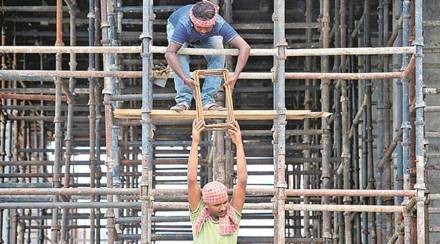Manufacturing activities scaled an eight-month peak in July as new order intakes rose substantially, recovering the growth momentum lost in June, amid improving demand. The seasonally-adjusted S&P Global India Manufacturing Purchasing Managers’ Index (PMI) jumped to 56.4 in July from 53.9 in the previous month. With this, the index has remained in the expansionary zone for the 13th straight month.
The latest PMI print indicates a broad-basing of the economic pick-up, despite the global headwinds. The services activity, as gauged by PMI, had expanded at the fastest pace in eleven years in June 2022, reflecting robust demand conditions. Also, agriculture output is seen to be strong in the wake of above-normal monsoon and kharif acreage being up 2% on year.
Importantly, input cost inflation eased to an 11-month low in July as supplies improved, weighing down the rate of increase in output prices to the weakest in four months, according to a release by S&P Global.
This will likely have a salutary impact on elevated retail inflation that remained above the central bank’s comfort level for a sixth straight month through June. The fresh momentum in manufacturing will also have a benign impact on the industrial sector in the second quarter, even as the favourable base effect starts to wane. Already, growth in the output of eight core infrastructure sectors hit 12.7% in June. The growth in the index of industrial production, too, is expected to remain in double digits in June.
With input prices easing, goods producers witnessed one of the fastest increases in their input holdings at least since early 2005, according to S&P Global. Inventories of finished products, meanwhile, continued to decline, suggesting an improvement in demand.
Pollyanna De Lima, economics associate director at S&P Global Market Intelligence, said: “The Indian manufacturing industry recorded a welcome combination of faster economic growth and softening inflation during July.”
However, job creation remained marginal “amid an uncertain outlook and a general lack of pressure on operating capacities” and as many as 98% of companies opted to leave workforce numbers unchanged.
Moreover, there was a noticeable slowdown in external sales and new export orders rose at a moderate pace, the weakest in the last four months, possibly mirroring a growth slowdown in advanced economies.
Though the upturn in demand gained strength, there were clear signs that capacity pressures remained mild as backlogs rose only marginally, apart from subdued job creation. “Purchasing activity growth ticked higher in July and firms were successful in their efforts to obtain inputs amid a second consecutive improvement in supplier performance. This in turn supported a near-record increase in inventories of raw materials and semi-finished goods as well as a softer upturn in input costs,” the S&P Global said.
In the PMI parlance, an index reading of 50 or above suggests expansion and below it points at contraction.
